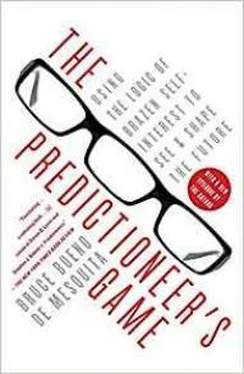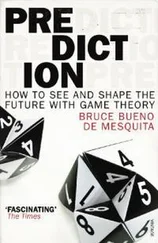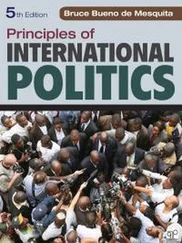With these values in hand, here are the expected payoffs at terminal nodes in the first iteration:
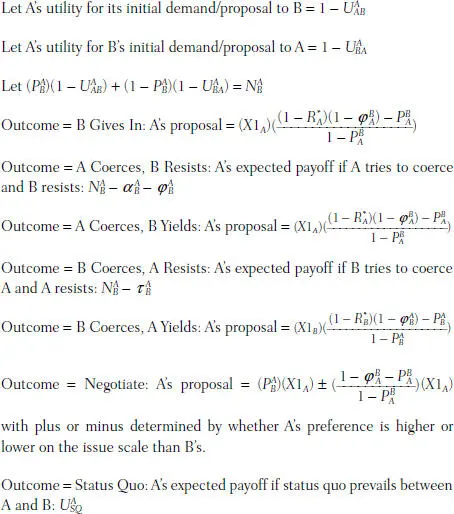
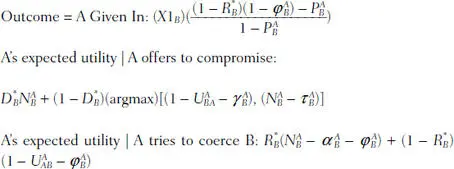
D* and R* denote, respectively, the belief that the subscripted player is a dove and a retaliator. These beliefs are updated in accordance with Bayes’ Rule. Off-the-equilibrium path beliefs are set at 0.5.
Proposals go back and forth between players, but not all proposals are credible. They are credible if the Outcome involves B giving in to A’s coercion or if the absolute value of the proposal being made minus the target’s current position relative to the range of available policy differences is less than the current resolve score of the target, with resolve defined in the next section.
The predicted new position of each player in a given round is determined as the weighted mean of the credible proposals it receives and the predicted outcome is the weighted mean of all credible proposals in the round, smoothed as the average of the weighted means including the adjacent rounds just before and after the round in question. The nature of the proposal in each dyadic game is determined by the equilibrium outcome expected in that stage of the game. The weighted mean reflects the credibly proposed positions weighted by clout multiplied by salience.
Phew, I hope the math mavens enjoyed that and the rest of you didn’t mind it too much.
Notes

Introduction
1. See Bruce Bueno de Mesquita, “Leopold II and the Selectorate: An Account in Contrast to a Racial Explanation,” Historical Social Research [Historische Sozialforschung] 32, no. 4 (2007): 203-21.
2. Vernon Mallinson, “Some Sources for the History of Education in Belgium,” British Journal of Educational Studies 4, no. 1 (November 1955): 62-70.
3. See, for instance, Joseph Conrad, Youth, and Two Other Stories (New York: McClure, Phillips, 1903); Barbara Emerson. Leopold II of the Belgians: King of Colonialism (London: Weidenfield and Nicolson, 1979); Peter Forbath, The River Congo (New York: Harper and Row, 1977); and Adam Hochschild, King Leopold’s Ghost (Boston: Mariner Books, 1999).
4. The discussion that follows is based on the logic and evidence provided in Bruce Bueno de Mesquita, Alastair Smith, Randolph M. Siverson, and James D. Morrow, The Logic of Political Survival (Cambridge, Mass.: MIT Press, 2003). See especially chapter 7. See also Bruce Bueno de Mesquita and Alastair Smith, “Political Survival and Endogenous Institutional Change,” Comparative Political Studies 42, no. 2 (February 2009): 167-97.
5. Petty dictators typically also have a pot of money that can be spent at their sole discretion. Democratic leaders have far less authority over spending. Discretionary funds can be used to benefit the citizenry or can be socked away in a secret bank account. One way to recognize civic-mindedness is to see how many benefits the public has compared to expectations, given the type of regime. Singapore’s Lee Kwan Yew and Chinas Deng Xiaoping, for instance, seem to have been genuinely civic-minded. They implemented effective public policies while sustaining the loyalty of their essential supporters. Kim Jong Il, Robert Mugabe, and Supreme Leader Ali Khamenei, in contrast and to varying degrees, seem not so civic-minded. See Bueno de Mesquita, Smith, Siverson, and Morrow, Logic of Political Survival .
6. Stanley Feder, “Factions and Policon: New Ways to Analyze Politics,” in H. Bradford Westerfield, ed., Inside CIA’s Private World: Declassified Articles from the Agency’s Internal Journal, 1955—1992 (New Haven: Yale University Press, 1995), and James L. Ray and Bruce M. Russett, “The Future as Arbiter of Theoretical Controversies: Predictions, Explanations and the End of the Cold War,” British Journal of Political Science 26, no. 4 (October 1996): 441-70.
Chapter 1: What Will It Take to Put You in This Car Today?
1. See the Jobs Rated Almanac ratings at http://www.egguevara.com/shopping/articles/jobsrated.html.
2. If you think body language is not important, do a search online for “negotiation and body language.” You will find article after article about how close sellers should place themselves to buyers, how they should use their hands and arms, facial expressions, etc. to improve the price they get and the odds of closing deals.
Chapter 2: Game Theory 101
1. John von Neumann and Oskar Morgenstern, Theory of Games and Economic Behavior (Princeton: Princeton University Press, 1947).
2. Sylvia Nasar, A Beautiful Mind: The Life of Mathematical Genius and Nobel Laureate John Nash (New York: Simon & Schuster, 1998). For progressively more thorough and technical introductions to game theory, starting with a completely readable nontechnical treatment, see Avinash K. Dixit and Barry J. Nalebuff, Thinking Strategically: The Competitive Edge in Business, Politics and Everyday Life (New York: W. W. Norton, 1991); James D. Morrow, Game Theory for Political Scientists (Princeton: Princeton University Press, 1994); Martin J. Osborne, An Introduction to Game Theory (Oxford: Oxford University Press, 2003); and Drew Fudenberg and Jean Tirole, Game Theory (Cambridge, Mass.: MIT Press, 1991).
3. Six dollars per day falls in the middle of the World Banks estimate of per capita income for Iraq in 2007. Unlike for most countries, for Iraq the World Bank is not able to provide a firm number. Other estimates seem to be based on the World Banks range.
4. Brian Kolodiejchuk, ed., Mother Teresa: Come Be My Light — The Private Writings of the Saint of Calcutta (New York: Doubleday, 2007).
5. See Irene Hau-siu Chow, Victor P. Lau, Thamis Wíng-chun Lo, Zhenquan Sha, and He Yun, “Service Quality in Restaurant Operations in China: Decision- and Experiential-Oriented Perspectives,” International Journal of Hospitality Management 26, no. 3 (September 2007): 698-710.
6. For the math mavens out there, the circle is a special case in which each dimension is of equal importance to the player. If one dimension is more important than the other, then we should draw an ellipse, each of whose radii reflects the relative importance of the issues. I skip this complicating detail here.
7. Those mathematically inclined and interested in delving more deeply into how it is possible for rational decision makers to move from any policy combination to any other, see Richard McKelvey, “Intransitivities in Multidimensional Voting Models and Some Implications for Agenda Control,” Journal of Economic Theory 12 (1976): 472-82; Richard McKelvey, “General Conditions for Global Intransitivities in Formal Voting Models,” Econometrica 47 (1979): 1085-1112; and Norman Schofield, “Instability of Simple Dynamic Games,” Review of Economic Studies 45 (1978): 575-94.
8. For a careful study of steroid use that is broadly consistent with the values used in this example, see Jenny Jakobsson Schulze, Jonas Lundmark, Mats Garle, Ilona Skílvíng. Lena Ekström, and Anders Rane, “Doping Test Results Dependent on Genotype of Uridine Diphospho-Glucuronosyl Transferase 2B17, the Major Enzyme for Testosterone Glucuronidation,” Journal of Clinical Endocrinology & Metabolism 93, no. 7 (July 2008): 2500-2506. Based on the values in this study, about 9 percent of a random sample from the population would falsely test positive. I assume 10 percent.
Читать дальше
